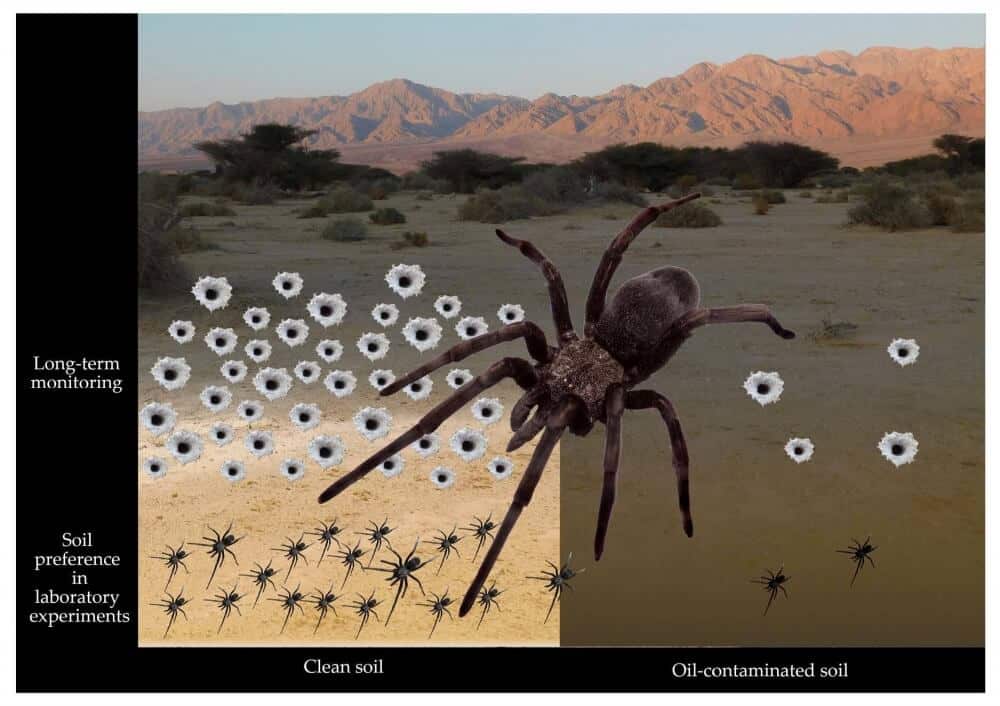The spider, which was discovered for the first time in the Arava region, prefers soils free of oil pollution and thus constitutes a biological marker

A recently published scientific article reveals a species of spider new to science that was discovered for the first time in the south of the Arabah, by Dr. Efrat Gavish-Regev, Director of the Arthropod Collection in the National Nature Collections at the Hebrew University, and Prof. Yael Lubin from Ben-Gurion University and their research teams. The researchers noticed the special spider during arachnid monitoring they carried out, which was designed to estimate the damages caused by the oil spill disasters in the south of the Arabah in 1975 and 2014. the spider called "Sahastata aravaensis . Ganem, Magalhaes, Zonstein and Gavish-Regev", has so far been recorded only from the region of Israel and Jordan.
The spider that was discovered is the largest of the species of the Hagvith family in Israel and stands out for its velvety black color. The researchers estimate that the spider's lifespan is about four years (a lot in spider terms), which it spends in a vertical burrow, lined with silk. After its discovery and at the end of five years of monitoring, the researchers found that the number of spider burrows in the areas polluted with oil in 2014 and 1975 is significantly lower compared to the number in nearby areas, which remained clean. In addition, it was found that the size of the spider burrows in the areas of the spill is significantly smaller than the size of the spider burrows in the areas that remained clean. In laboratory experiments, in which spiders of the new species were placed in containers divided between contaminated soil and clean soil, it could be seen that most of the spiders settled on the clean soil, already at the end of the first day of the experiment.
Dr. Gabish-Regev explained the findings: "The monitoring data and the results of the laboratory experiment suggest that oil has a long-term effect on the land and the animals that use the land for living. These findings emphasize the fact that many of the secrets of the Israeli desert have not yet been revealed to us," adds Dr. Gabish Regev, "but also bring alarming data about the fragility of the desert ecology in the face of human hazards."
The scientific article in which the new spider is described
Another article that is now being published, and among its authors is Dr. Gabish-Regev, deals with the evolution of the arachnid department and the conquest of land by ancient arachnids. The article attempts to resolve the evolutionary relationships between the different arachnids series, with the help of the largest molecular database published so far, which includes 506 genomes of arachnids belonging to the contemporary arachnid series. Protozoa are arthropods with protozoan mouthparts, which include spiders, scorpions, ticks, and more. In contrast, there are series of arthropods with mouthparts of the jaw type that include the insects, the multi-legged crustaceans and the mandals. As part of the research, a number of unique genomes of desert arachnids collected in Israel were sequenced (for example long-legged mites (Opilioacariformes), Solifugae and scorpions).
In addition, the researchers created a morphological database that includes 514 contemporary representatives and fossils of extinct clients in order to better understand the evolutionary relationships between extinct series and series with contemporary representatives, and to examine the influence of morphological data on the phylogenetic tree in relation to the influence of molecular data. The important result of this study indicates that aquatic consumers such as contemporary species of swordtail (horseshoe crabs) and extinct sea scorpions, nested within the Arachnid class, which was considered a terrestrial group until now. "This result affects our understanding of the evolution of the Malkochanim," explains Dr. Gabish-Regev. "If until now it was accepted that the arachnids are a terrestrial class with a single ancestor who conquered the land, following this article the new hypothesis holds that there were several separate conquests of the land by malkohnim, and that the 'Arachnid' are a group that also includes marine malkohnim that were previously considered ancient and were proposed As relatives of the marine ancestor of the terrestrial 'Arachnids', but not included in the Arachnid class".
These two studies emphasize the importance of discovering and documenting biological diversity, the basic research done in the national nature collections at the Hebrew University of Jerusalem, and its practical implications in nature conservation and its great contribution to understanding the evolutionary history of life on Earth.
The published scientific article on the evolution of arachnids
More of the topic in Hayadan:
- Whales in the Sahara - a new educational series 2 about evolution
- Neil deGrasse Tyson, presenter of the Cosmos series: "If Sagan were alive, he would be most surprised by the fact that we still have to argue that science is important to society."
- Bacteria will be able to produce proteins for use in space
- x-prize: good for manned space flights, why not use it to solve difficult medical and scientific problems
- An EU project is trying to mimic the processing of biological nervous systems
